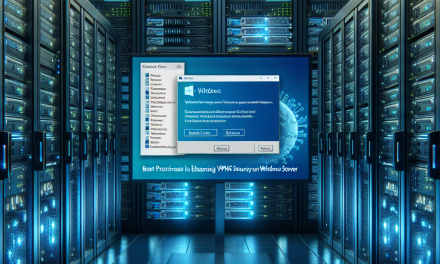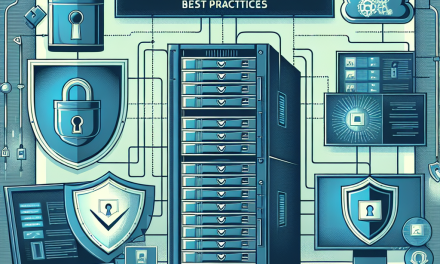As businesses increasingly adopt hybrid cloud environments, securing Windows Server deployments becomes paramount. A hybrid cloud architecture combines on-premises infrastructure with public cloud resources, allowing organizations to enjoy the best of both worlds. However, this complicates security, necessitating a robust strategy. Here’s a comprehensive guide on best practices for securing your Windows Server in a hybrid cloud environment.
1. Implement Strong Authentication Mechanisms
Multi-Factor Authentication (MFA)
- Why: MFA adds an additional layer of security beyond just usernames and passwords.
- How: Enable MFA for all administrative accounts and encourage its use for all user accounts, especially those accessing sensitive data or performing administrative tasks.
Active Directory Federation Services (AD FS)
- Why: AD FS provides a single sign-on (SSO) solution, streamlining access while enhancing security.
- How: Integrate AD FS in your hybrid environment to manage identities effectively.
2. Regularly Update and Patch Systems
Automate Patch Management
- Why: Keeping your Windows Server up to date is crucial for protecting against vulnerabilities.
- How: Use Windows Server Update Services (WSUS) or System Center Configuration Manager (SCCM) to automate the deployment of updates.
Review Patch Policies
- Why: Not all patches are created equal; some may conflict with existing applications.
- How: Test updates in a development environment before deploying them widely.
3. Employ Network Security Controls
Implement a Virtual Private Network (VPN)
- Why: A VPN encrypts traffic between on-premises and cloud resources, protecting data from eavesdropping.
- How: Set up a dedicated site-to-site VPN to ensure secure communications.
Use Network Security Groups (NSGs)
- Why: NSGs control traffic to and from your Windows Server instances in the cloud.
- How: Define rules in your NSGs to manage inbound and outbound traffic based on least-privilege principles.
4. Leverage Identity and Access Management (IAM)
Role-Based Access Control (RBAC)
- Why: RBAC minimizes the risk of unauthorized access by ensuring users have only the necessary permissions.
- How: Define roles according to job functions and restrict access to resources accordingly.
Regular Access Reviews
- Why: User accounts may accumulate permissions that are no longer needed.
- How: Conduct periodic reviews to revoke unnecessary access rights.
5. Enable Encryption
Encrypt Data at Rest and in Transit
- Why: Encryption protects sensitive data from unauthorized access.
- How: Utilize BitLocker for encrypting data at rest on Windows Servers and implement SSL/TLS for data in transit.
Key Management
- Why: Proper management of encryption keys is critical for maintaining security.
- How: Use Azure Key Vault or other secure key management solutions to manage cryptographic keys.
6. Monitor and Audit Activities
Implement Security Information and Event Management (SIEM)
- Why: SIEM solutions provide real-time monitoring and analysis of security events.
- How: Deploy a SIEM solution tailored for Windows Servers to collect and analyze logging data.
Enable Windows Security Auditing
- Why: Auditing helps in tracking changes and detecting suspicious activities.
- How: Configure Security Event Logs for critical actions such as logons, file access, and changes to privileged accounts.
7. Backup and Disaster Recovery Planning
Regular Backups
- Why: Data loss can occur due to various reasons, including cyberattacks.
- How: Use Windows Server Backup or third-party solutions to schedule regular backups.
Test Your Recovery Plan
- Why: It’s not enough to have backups; you must ensure they work.
- How: Conduct regular disaster recovery drills to validate your backup and restore procedures.
8. Educate and Train Staff
Security Awareness Training
- Why: Human error is a significant factor in security breaches.
- How: Implement regular training to raise awareness about security threats, phishing attacks, and best practices.
Define Security Policies
- Why: Clear policies guide employee behavior regarding security practices.
- How: Create and disseminate comprehensive documentation on acceptable use, incident response, and reporting procedures.
Conclusion
Securing Windows Server in a hybrid cloud environment requires a multi-faceted approach that incorporates technological solutions, ongoing policy management, and employee training. By implementing these best practices, organizations can better protect their data, maintain compliance, and reduce the risk of security incidents in their hybrid cloud infrastructure.
Stay informed and proactive to ensure the security of your Windows Server deployments—because in today’s digital landscape, security is everyone’s responsibility!
By adhering to these best practices, organizations can navigate the complexities of a hybrid cloud environment while maintaining a strong security posture. For more insightful articles, tips, and updates on technology trends, stay tuned to WafaTech Blogs.





